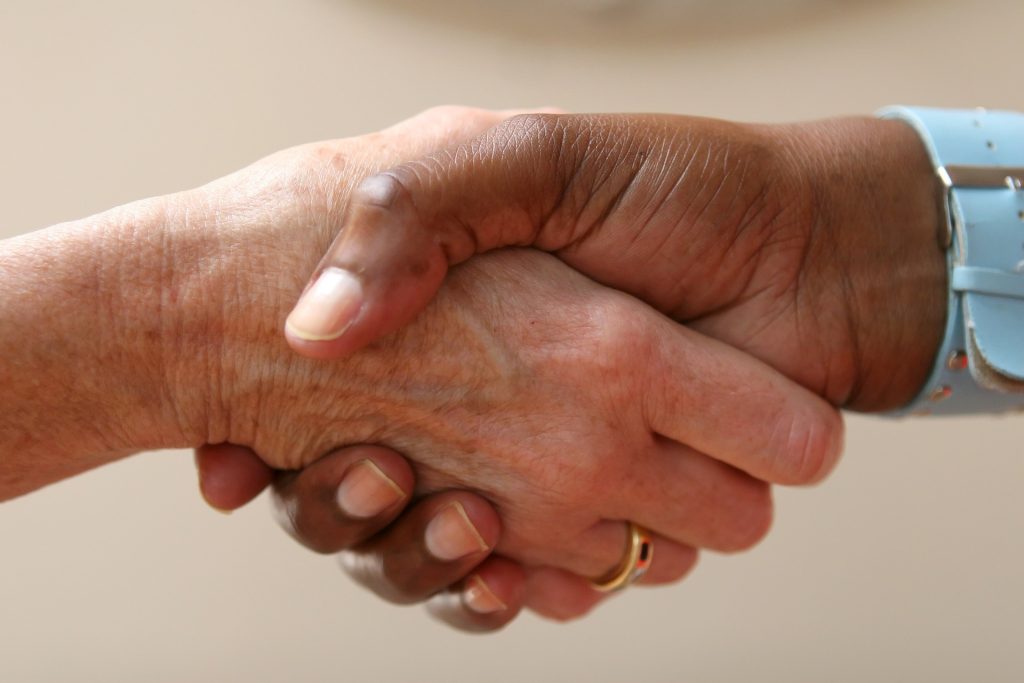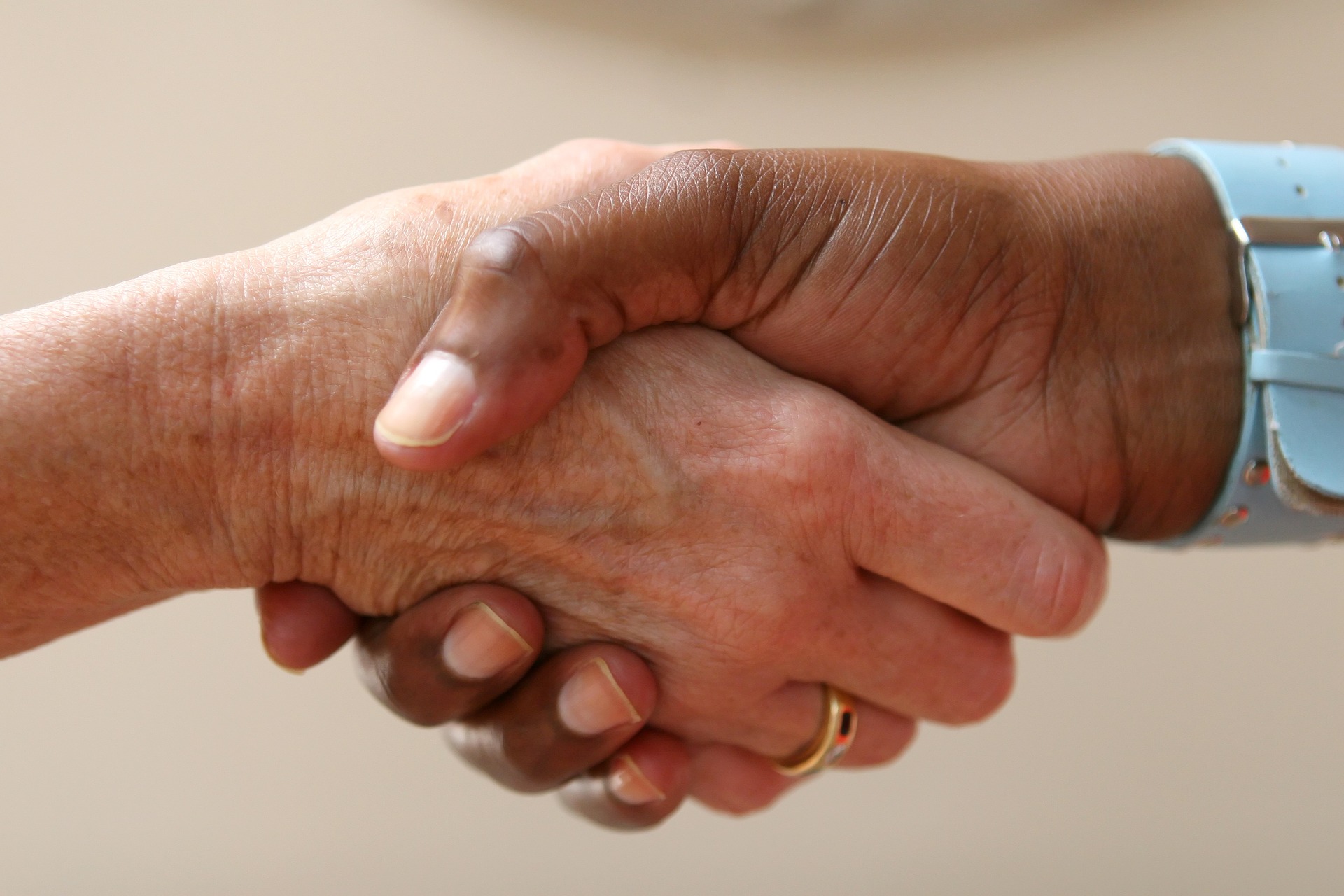
You might have heard that you only have 7 seconds to make a good first impression. Much of that impression is made up of your appearance, your perceived confidence and competence, and your friendliness. What you might not know is that a good handshake can radically boost the first impression you make, and that it can help you build rapport equivalent to that of a 3 hour meeting! Read on to see why the handshake is so effective, how to give a good one, and what to do if the normal rules don’t apply.
The way of the handshake
Shaking a new contact’s hand is a universally accepted greeting in both professional and social situations. This is because a hug is considered too intimate and may be culturally inappropriate, and doing nothing feels awkward (though some cultures substitute with a bow – more on that later). But why is this? It’s thought that the ancient handshake was a way to signal peace and cooperation – open palms showed that you weren’t carrying a weapon.
On a more basic level, humans are programmed to respond to physical touch. As babies, before we’ve learnt to understand what we see and hear, we respond to physical touch. A friendly touch is instantly soothing and reduces stress. In fact, research shows that it can even foster trust and cooperation. So, it makes sense that the handshake has evolved into a common greeting, particularly in professional settings where parties with competing interests are trying to compromise on a mutually acceptable solution.
The how of a good handshake
Most of us have shaken hundreds if not thousands of hands, and most of these interactions have been uneventful. But occasionally, one encounters a terrible handshake, and without being able to say why, we’re immediately put off by the shaker. Chances are, the terrible handshake violated one of the 5 rules below:
1) Good hygiene
Nobody wants to shake a dirty, greasy, wet, sweaty, or sticky hand. So, before reaching out, make sure your hand is clean and dry. Bonus points for being warm too. If you do have to extend a cold hand, you can make an apology for it, say something about the inhospitable weather lately, and perhaps use the opportunity to engage in some ice-breaking small talk.
2) Good pressure
Your handshake should say ‘I’m friendly and competent’. So, there’s no need to give a death grip by crushing the other person’s fingers. Conversely, laying your hand lazily on the other person’s palm or giving a timid squeeze is also terrible. Most etiquette experts recommend firm, continuous pressure and the ‘web’. This means that when you reach out for the shake, the webbing between your thumb and forefinger should be touching the web on the other person’s hand.
Another thing to keep in mind is the length of your nails. Long, pointy, or jagged nails could dig into the other person’s hand, so make sure yours are neat and trimmed.
3) Good eye contact
The handshake is meant to build rapport, but people often spoil it by not looking the recipient in the eye. You often see this in group settings, where the person shaking person A’s hand has already skipped ahead to look at person B. Make sure you’re smiling and making eye contact with the person you’re shaking hands with. There’s no need to look at your respective hands, as your peripheral vision will guide you to make contact. And besides, you’re making friends with the person, not the hand.
4) Good timing
In principle, you should shake hands as soon as possible. So, during the initial meet-and-greet. If for some reason this isn’t possible (perhaps someone arrived late and missed the introductions), do so as soon as practical – if you’re responding to something they’ve said, or during a natural break in conversation, or if more refreshments are being offered, for example.
In terms of timing, the length of your handshake should also be carefully controlled. You’re aiming for between 2-5 seconds. Too brief feels insincere, and too long feels aggressive or uncomfortable.
5) Good manners
Stand when you’re shaking hands, and greet everyone. In a social situation, you might greet the people you know first, in order to give them the chance to introduce you to the new people. Alternatively, you could greet people based on proximity to you, starting with those closest to you, and working your way around. In a professional setting, you could also use the proximity rule, or greet in order of hierarchy.
What to do when the normal rules don’t apply
Sometimes, you might be unable to offer a handshake. For example, if the other person is elderly, or suffers from arthritis. Health care professionals may also avoid handshakes for fear of germs. Some cultures also discourage physical contact between members of the opposite sex. If you’re unsure, simply ask ‘May I shake your hand?’ Depending on the situation, you could offer a gentler handshake, or an alternative. If the person is not too stuffy, you could offer a fistbump. Bowing or a nod of the head may sometimes be better.
As Kalido is all about helping you make relevant online contacts, and turning them into genuine relationships in the real world, we anticipate that you’ll be doing a good amount of handshaking. Just remember the 5 rules, and we’re sure you’ll make a great impression in both your professional and social circles!

